Evaluation of a Laboratory-Scale Gas-Atomized AlSi10Mg Powder and a Commercial-Grade Counterpart for Laser Powder Bed Fusion Processing
Abstract
1. Introduction
2. Materials and Methods
2.1. Materials
2.2. Methods
- The volume PSD analysis was performed with a Mastersizer 3000 Malvern Panalytical, (Malvern Instruments, Malvern, UK).
- The morphology of the powders was observed by a scanning electron microscope (SEM) using a Phenom Pro X (ThermoFisher, Waltham, MA, USA).
- For the number PSD detection, the SEM images were analyzed with ImageJ (version 1.52t, https://imagej.nih.gov/ij/download.html, accessed on 1 August 2022), an image processing software in Java, developed by the National Institutes of Health, United States (The images analyzed per samples were about 130, with a range of 50,000–100,000 particles analyzed per sample.
- The flowability and tap density tests were performed with instruments compliant with the standard ASTM B213 and ASTM B527-22 [21,22]. In particular, the flowability was carried out on three samples of 50 g per powder. A cylinder of 100 mL with 100 g per powder was used to perform the tap density. The test was repeated three times.
- The oxygen (O), nitrogen (N) and hydrogen (H) levels of the powders were detected with a ONH836 analyzer, by LECO (LECO, St. Joseph, MI, USA). Three samples of 0.2 g per powder were analyzed, and the result was an average of these measurements. LECO supplied the program used for the heating cycle and testing, which is compatible with aluminum alloys.
3. Results and Discussion
3.1. Powder Characterization
3.2. Bulk Samples Comparison
4. Conclusions
Author Contributions
Funding
Institutional Review Board Statement
Informed Consent Statement
Data Availability Statement
Acknowledgments
Conflicts of Interest
References
- Wallner, S. Powder Production Technologies. BHM Berg-Und Hüttenmännische Mon. 2019, 164, 108–111. [Google Scholar] [CrossRef]
- Sun, P.; Zak Fang, Z.; Zhang, Y.; Xia, Y. Review of the Methods for Production of Spherical Ti and Ti Alloy Powder. JOM 2017, 69, 1853–1860. [Google Scholar] [CrossRef]
- Kassym, K.; Perveen, A. Atomization Processes of Metal Powders for 3D Printing. Mater. Today Proc. 2020, 26, 1727–1733. [Google Scholar] [CrossRef]
- Li, X.G.; Zhu, Q.; Shu, S.; Fan, J.Z.; Zhang, S.M. Fine Spherical Powder Production during Gas Atomization of Pressurized Melts through Melt Nozzles with a Small Inner Diameter. Powder Technol. 2019, 356, 759–768. [Google Scholar] [CrossRef]
- Urionabarrenetxea, E.; Avello, A.; Rivas, A.; Martín, J.M. Experimental Study of the Influence of Operational and Geometric Variables on the Powders Produced by Close-Coupled Gas Atomisation. Mater. Des. 2021, 199, 109441. [Google Scholar] [CrossRef]
- Tamura, R.; Osada, T.; Minagawa, K.; Kohata, T.; Hirosawa, M.; Tsuda, K.; Kawagishi, K. Machine Learning-Driven Optimization in Powder Manufacturing of Ni-Co Based Superalloy. Mater. Des. 2021, 198, 109290. [Google Scholar] [CrossRef]
- Im, W.B.; Park, S.J.; Yun, Y.C.; Kim, B.C. Manufacture of AlSi10Mg Alloy Powder for Powder Bed Fusion(PBF) Process Using Gas Atomization Method. J. Korean Powder Metall. Inst. 2021, 28, 120–126. [Google Scholar] [CrossRef]
- ASTM F3049-14; Standard Guide for Characterizing Properties of Metal Powders Used for Additive Manufacturing Processes 1. ASTM International: West Conshohocken, PA, USA, 2021.
- Mussatto, A.; Groarke, R.; O’Neill, A.; Obeidi, M.A.; Delaure, Y.; Brabazon, D. Influences of Powder Morphology and Spreading Parameters on the Powder Bed Topography Uniformity in Powder Bed Fusion Metal Additive Manufacturing. Addit. Manuf. 2021, 38, 101807. [Google Scholar] [CrossRef]
- Popovich, A.; Sufiiarov, V. Metal Powder Additive Manufacturing. In New Trends in 3D Printing, 1st ed.; Shishkovsky, I.V., Ed.; IntechOpen: London, UK, 2016; Volume 1, pp. 215–236. [Google Scholar] [CrossRef]
- Averardi, A.; Cola, C.; Zeltmann, S.E.; Gupta, N. Effect of Particle Size Distribution on the Packing of Powder Beds: A Critical Discussion Relevant to Additive Manufacturing. Mater. Today Commun. 2020, 24, 100964. [Google Scholar] [CrossRef]
- Coe, H.G.; Pasebani, S. Use of Bimodal Particle Size Distribution in Selective Laser Melting of 316L Stainless Steel. J. Manuf. Mater. Process. 2020, 4, 8. [Google Scholar] [CrossRef]
- Boley, C.D.; Khairallah, S.A.; Rubenchik, A.M. Calculation of Laser Absorption by Metal Powders in Additive Manufacturing. Appl. Opt. 2015, 54, 2477. [Google Scholar] [CrossRef]
- Engeli, R.; Etter, T.; Hövel, S.; Wegener, K. Processability of Different IN738LC Powder Batches by Selective Laser Melting. J. Mater. Process. Technol. 2016, 229, 484–491. [Google Scholar] [CrossRef]
- Leung, C.L.A.; Marussi, S.; Towrie, M.; Atwood, R.C.; Withers, P.J.; Lee, P.D. The Effect of Powder Oxidation on Defect Formation in Laser Additive Manufacturing. Acta Mater. 2019, 166, 294–305. [Google Scholar] [CrossRef]
- Chen, G.; Zhao, S.Y.; Tan, P.; Wang, J.; Xiang, C.S.; Tang, H.P. A Comparative Study of Ti-6Al-4V Powders for Additive Manufacturing by Gas Atomization, Plasma Rotating Electrode Process and Plasma Atomization. Powder Technol. 2018, 333, 38–46. [Google Scholar] [CrossRef]
- Brika, S.E.; Letenneur, M.; Dion, C.A.; Brailovski, V. Influence of Particle Morphology and Size Distribution on the Powder Flowability and Laser Powder Bed Fusion Manufacturability of Ti-6Al-4V Alloy. Addit. Manuf. 2020, 31, 100929. [Google Scholar] [CrossRef]
- Gao, C.F.; Xiao, Z.Y.; Zou, H.P.; Liu, Z.Q.; Chen, J.; Li, S.K.; Zhang, D.T. Characterization of spherical AlSi10Mg powder produced by double-nozzle gas atomization using different parameters. Trans. Nonferrous Met. Soc. China Engl. Ed. 2019, 29, 374–384. [Google Scholar] [CrossRef]
- Del Rio, D.C.; Jensen, J.; Yu, T.; Tiedje, N.S. Laboratory-Scale Gas Atomizer for the Manufacturing of Metallic Powders. IOP Conf. Ser. Mater. Sci. Eng. 2022, 1249, 01203. [Google Scholar] [CrossRef]
- Hinrichs, F.; Kauffmann, A.; Schliephake, D.; Seils, S.; Obert, S.; Ratschbacher, K.; Allen, M.; Pundt, A.; Heilmaier, M. Flexible Powder Production for Additive Manufacturing of Refractory Metal-Based Alloys. Metals 2021, 11, 1723. [Google Scholar] [CrossRef]
- ASTM B213-20; Standard Test Methods for Flow Rate of Metal Powders Using the Hall Flowmeter Funnel. ASTM International: West Conshohocken, PA, USA, 2020.
- ASTM B527-22; Standard Test Method for Tap Density of Metal Powders and Compounds 1. ASTM international: West Conshohocken, PA, USA, 2022.
- ASTM E8/E8M-21; Standard Test Methods for Tension Testing of Metallic Materials 1. ASTM international: West Conshohocken, PA, USA, 2022.
- Iams, A.D.; Gao, M.Z.; Shetty, A.; Palmer, T.A. Influence of Particle Size on Powder Rheology and Effects on Mass Flow during Directed Energy Deposition Additive Manufacturing. Powder Technol. 2022, 396, 316–326. [Google Scholar] [CrossRef]
- Sutton, A.T.; Kriewall, C.S.; Leu, M.C.; Newkirk, J.W. Powder characterisation techniques and effects of powder characteristics on part properties in powder-bed fusion processes. Virtual Phys. Prototyp. 2016, 12, 3–29. [Google Scholar] [CrossRef]
- Haferkamp, L.; Haudenschild, L.; Spierings, A.; Wegener, K.; Riener, K.; Ziegelmeier, S.; Leichtfried, G.J.; Ziegelmeier, S.; De, S.Z. Metals The Influence of Particle Shape, Powder Flowability, and Powder Layer Density on Part Density in Laser Powder Bed Fusion. Metals 2021, 11, 418. [Google Scholar] [CrossRef]
- Abdullah, E.C.; Geldart, D. The Use of Bulk Density Measurements as Flowability Indicators. Powder Technol. 1999, 102, 151–165. [Google Scholar] [CrossRef]
- Kearns, M. Development and Applications of Ultrafine Aluminium Powders. Mater. Sci. Eng. A 2004, 375–377, 120–126. [Google Scholar] [CrossRef]
- Marola, S.; Manfredi, D.; Fiore, G.; Poletti, M.G.; Lombardi, M.; Fino, P.; Battezzati, L. A Comparison of Selective Laser Melting with Bulk Rapid Solidification of AlSi10Mg Alloy. J. Alloys Compd. 2018, 742, 271–279. [Google Scholar] [CrossRef]
- Thijs, L.; Kempen, K.; Kruth, J.P.; van Humbeeck, J. Fine-Structured Aluminium Products with Controllable Texture by Selective Laser Melting of Pre-Alloyed AlSi10Mg Powder. Acta Mater. 2013, 61, 1809–1819. [Google Scholar] [CrossRef]
- Kempen, K.; Thijs, L.; van Humbeeck, J.; Kruth, J.P. Mechanical Properties of AlSi10Mg Produced by Selective Laser Melting. Phys. Procedia 2012, 39, 439–446. [Google Scholar] [CrossRef]
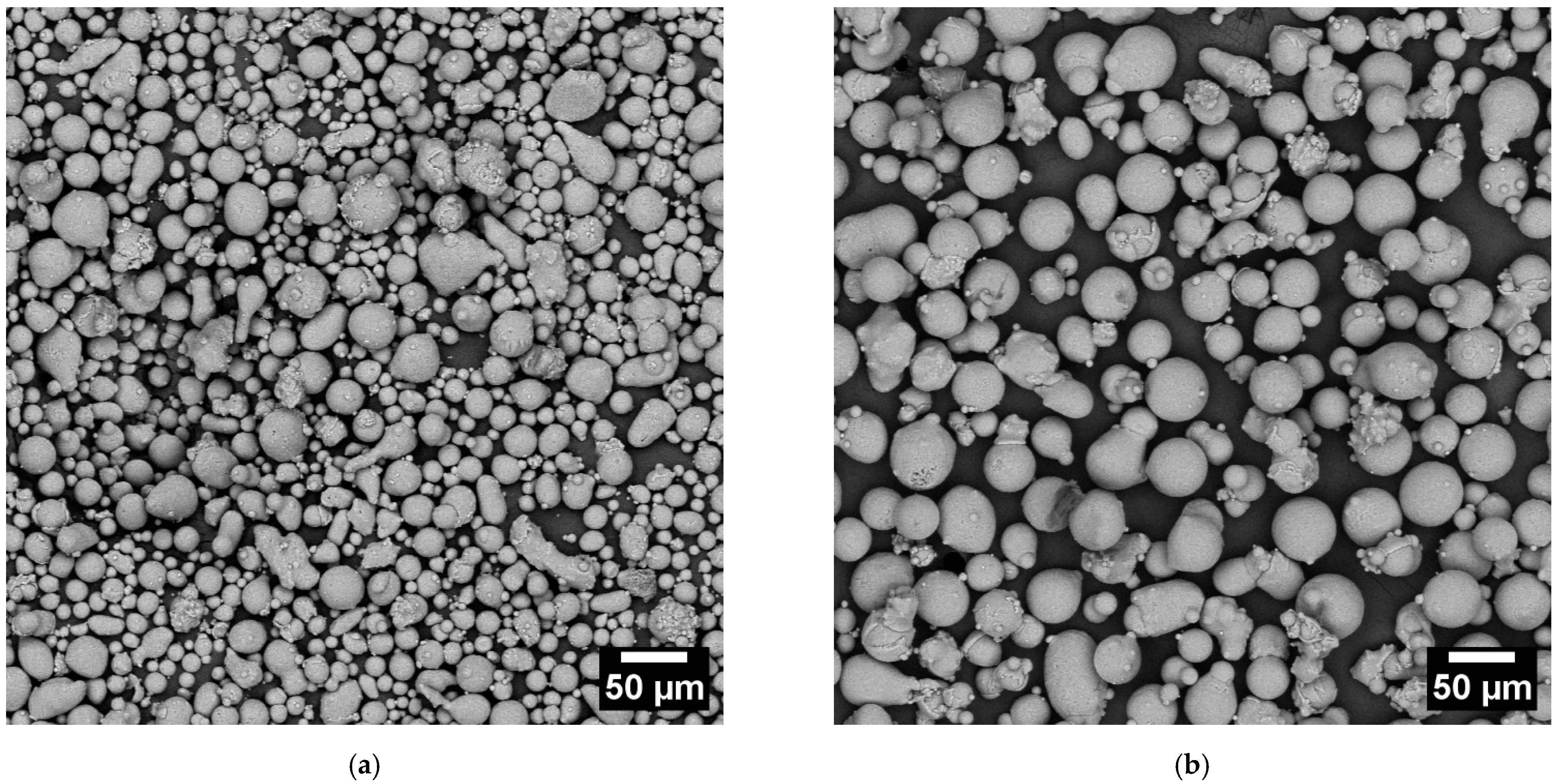
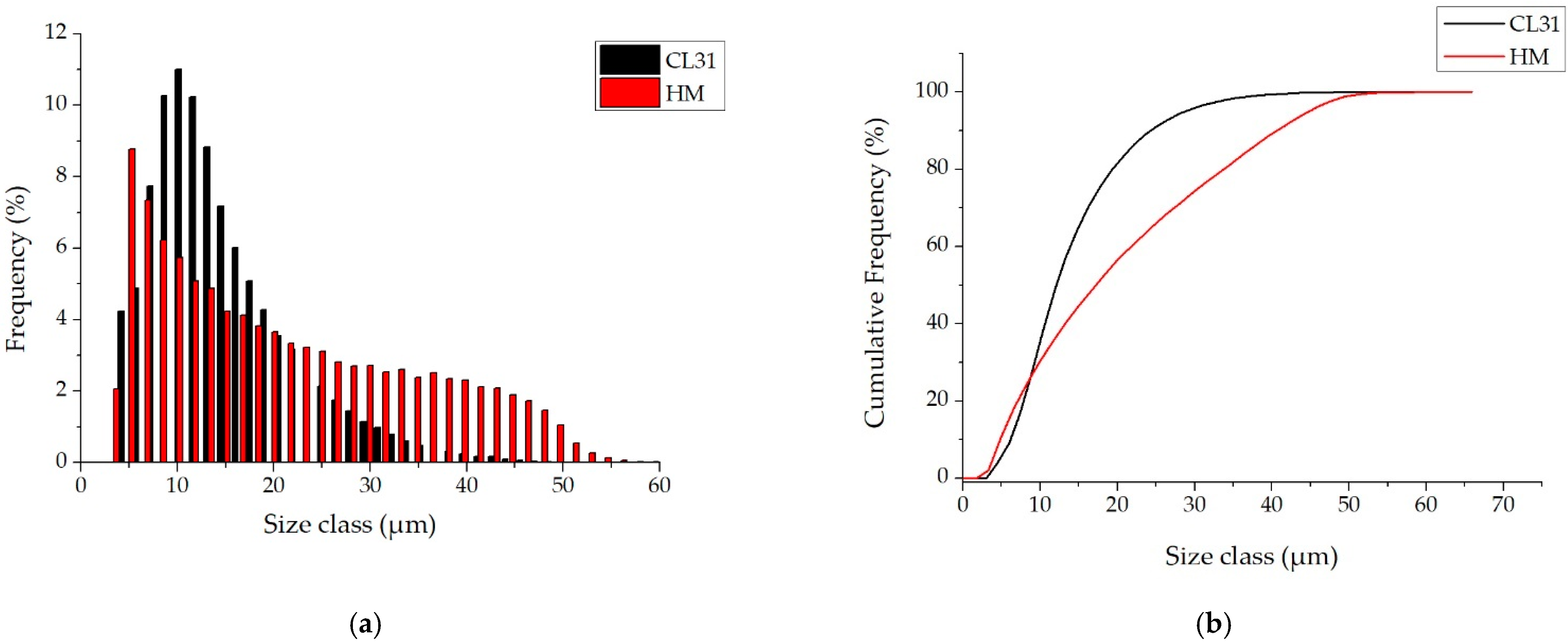
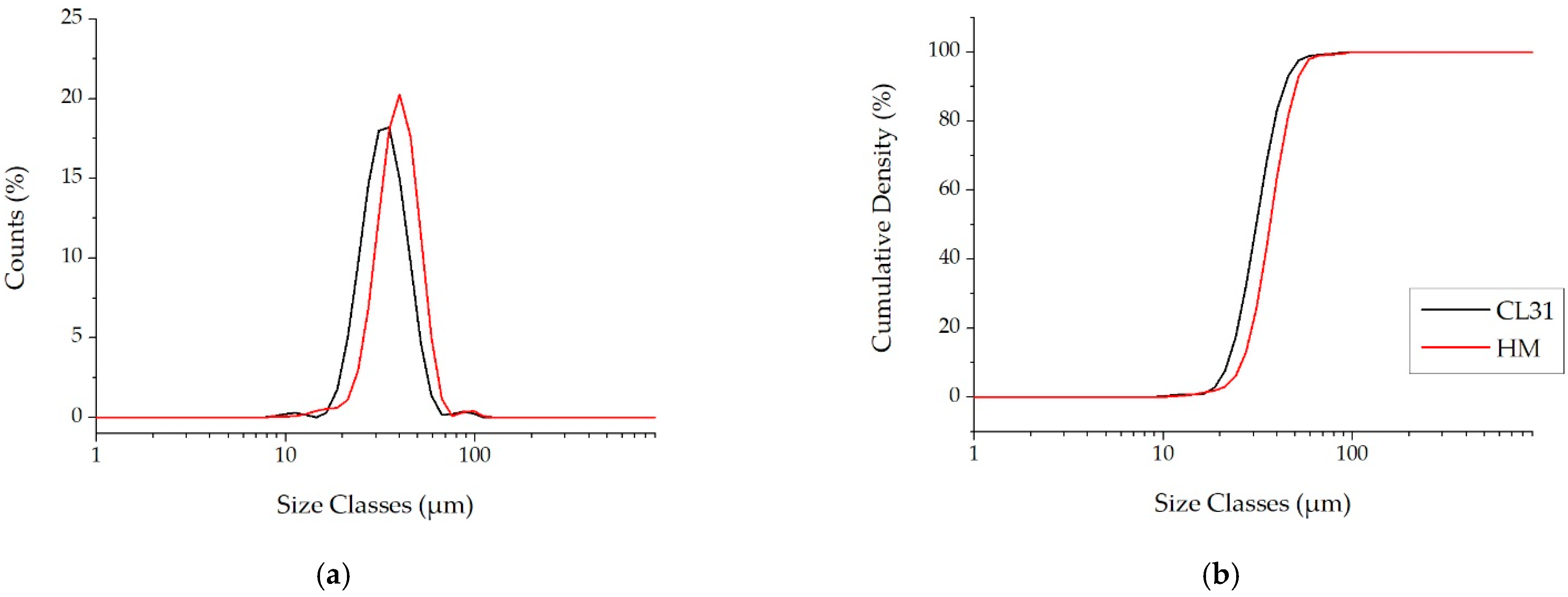
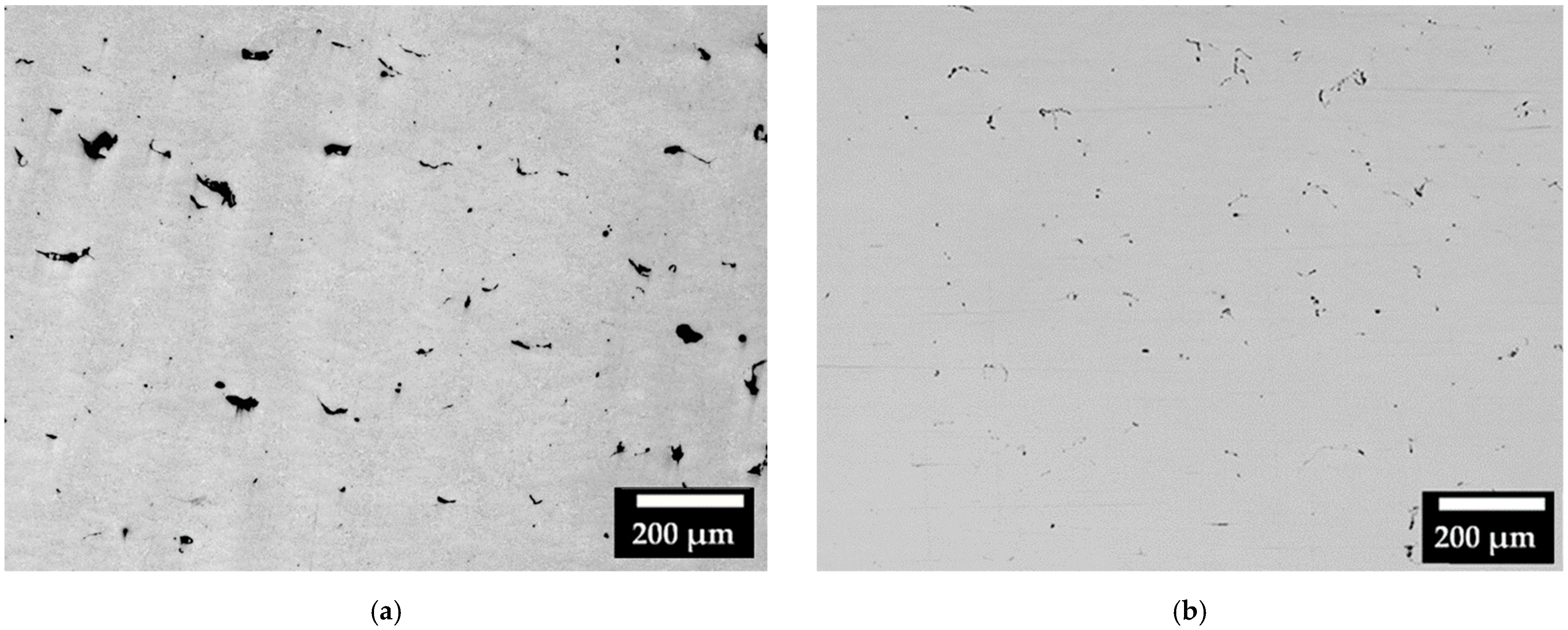
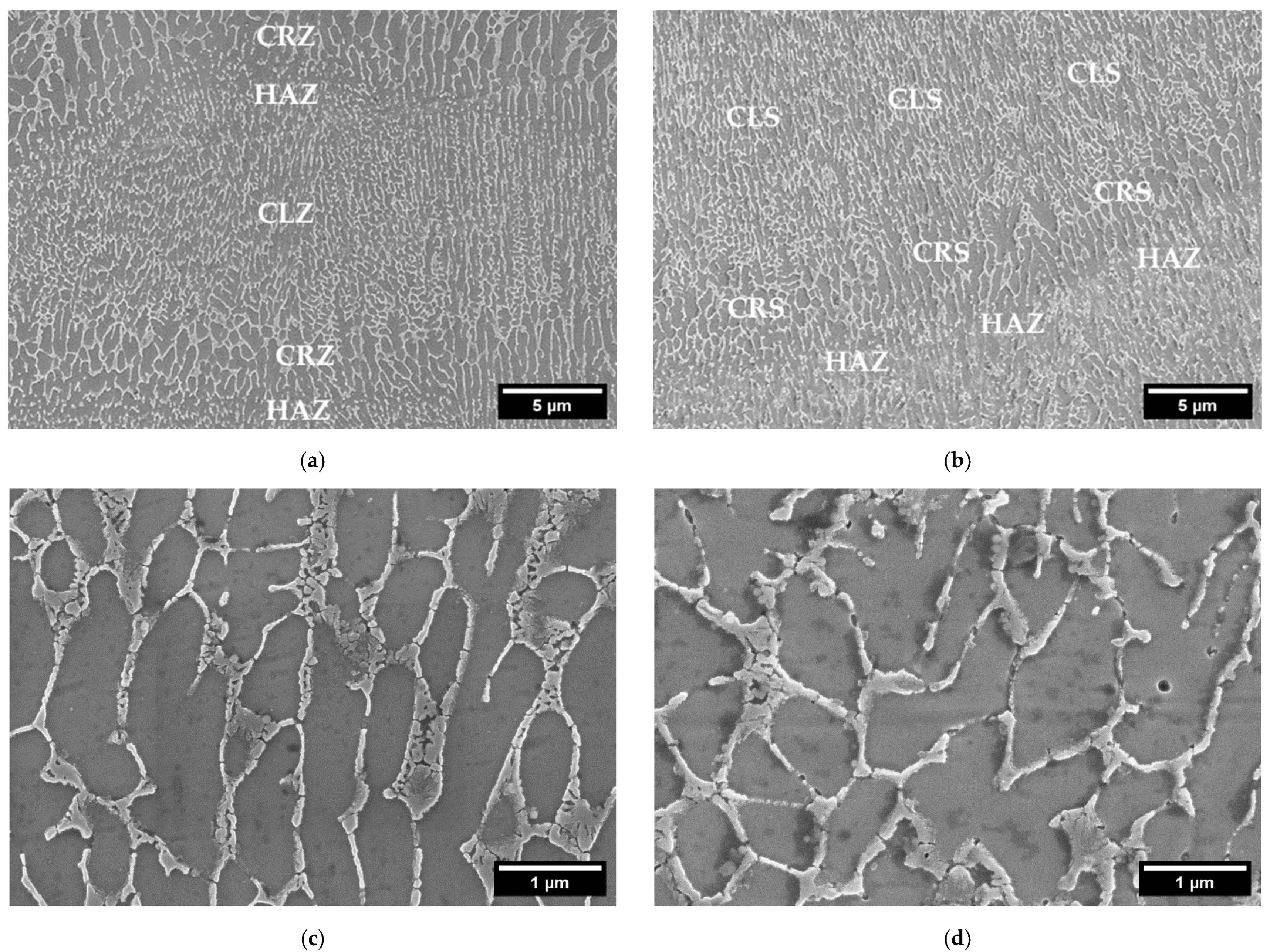
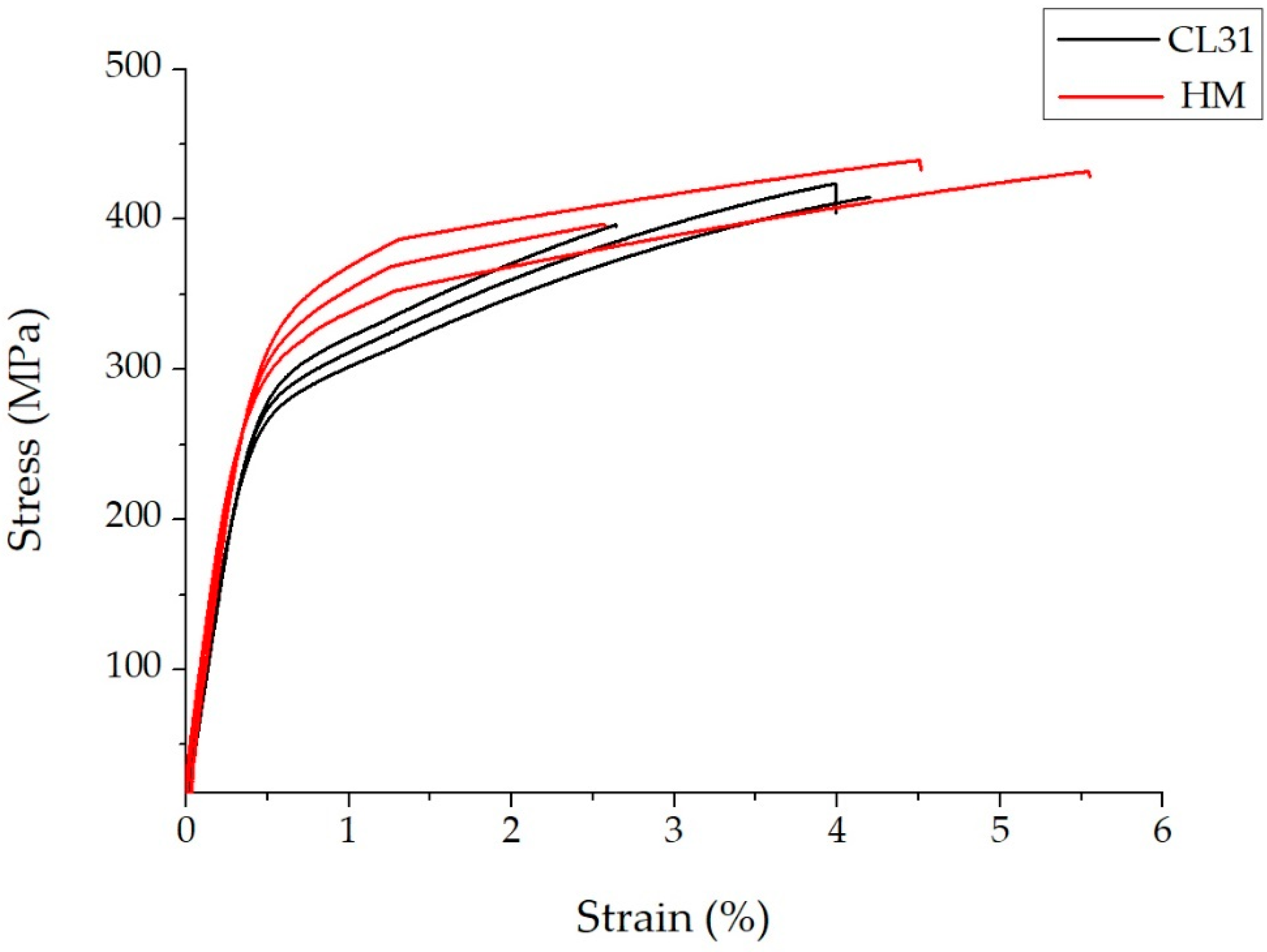
| Element (%) | Si | Fe | Cu | Mn | Mg | Ti | Al |
|---|---|---|---|---|---|---|---|
| AlSi10Mg | 9–11 | ≤0.55 | ≤0.05 | ≤0.45 | ≤0.2–0.45 | ≤0.15 | Balance |
| Powder | (µm) | (µm) | (µm) |
|---|---|---|---|
| CL31 | 6.1 | 12.2 | 24.2 |
| HM | 4.8 | 17.1 | 40.7 |
| Powder | (µm) | (µm) | (µm) |
|---|---|---|---|
| CL31 | 24.8 | 35.3 | 49.8 |
| HM | 29.5 | 41.8 | 57 |
| Powder | Flow Rate | Apparent Density (g/cm3) | Tap Density (g/cm3) | Hausner Ratio |
|---|---|---|---|---|
| CL31 | No flow | 1.45 ± 0.02 | 1.65 ± 0.01 | 1.14 |
| HM | No flow | 1.41 ± 0.03 | 1.53 ± 0.02 | 1.09 |
| Powder | O (%) | N (%) | H (ppm) |
|---|---|---|---|
| CL31 | 0.0878 ± 0.0159 | 0.0095 ± 0.0005 | 54.9 ± 0.9 |
| HM | 0.0287 ± 0.0007 | 0.0048 ± 0.0002 | 20.1 ± 22.7 |
| Powder | CL31 | HM | Δ (%) | AlSi10Mg [31] |
|---|---|---|---|---|
| E (GPa) | 65 ± 4 | 65 ± 4 | 0 | 68 ± 4 |
| YS (MPa) | 286 ± 8 | 323 ± 14 | 13 | - |
| UTS (MPa) | 412 ± 14 | 422 ± 23 | 2.4 | 391 ± 6 |
| (%) | 3.6 ± 0.8 | 4.1 ± 1.5 | 14 | 5.5 ± 0.4 |
| HV | 135 ± 9 | 139 ± 5 | 3 | - |
Publisher’s Note: MDPI stays neutral with regard to jurisdictional claims in published maps and institutional affiliations. |
© 2022 by the authors. Licensee MDPI, Basel, Switzerland. This article is an open access article distributed under the terms and conditions of the Creative Commons Attribution (CC BY) license (https://creativecommons.org/licenses/by/4.0/).
Share and Cite
Marinucci, F.; Aversa, A.; Manfredi, D.; Lombardi, M.; Fino, P. Evaluation of a Laboratory-Scale Gas-Atomized AlSi10Mg Powder and a Commercial-Grade Counterpart for Laser Powder Bed Fusion Processing. Materials 2022, 15, 7565. https://doi.org/10.3390/ma15217565
Marinucci F, Aversa A, Manfredi D, Lombardi M, Fino P. Evaluation of a Laboratory-Scale Gas-Atomized AlSi10Mg Powder and a Commercial-Grade Counterpart for Laser Powder Bed Fusion Processing. Materials. 2022; 15(21):7565. https://doi.org/10.3390/ma15217565
Chicago/Turabian StyleMarinucci, Fabrizio, Alberta Aversa, Diego Manfredi, Mariangela Lombardi, and Paolo Fino. 2022. "Evaluation of a Laboratory-Scale Gas-Atomized AlSi10Mg Powder and a Commercial-Grade Counterpart for Laser Powder Bed Fusion Processing" Materials 15, no. 21: 7565. https://doi.org/10.3390/ma15217565
APA StyleMarinucci, F., Aversa, A., Manfredi, D., Lombardi, M., & Fino, P. (2022). Evaluation of a Laboratory-Scale Gas-Atomized AlSi10Mg Powder and a Commercial-Grade Counterpart for Laser Powder Bed Fusion Processing. Materials, 15(21), 7565. https://doi.org/10.3390/ma15217565










